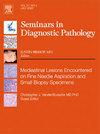术中肺标本冰冻切片诊断:最新综述
IF 3.5
3区 医学
Q2 MEDICAL LABORATORY TECHNOLOGY
引用次数: 0
摘要
术中冷冻切片(FS)诊断是肺病变患者治疗的关键步骤,为手术切除提供指导。术中FS诊断需要综合临床信息、影像学表现和组织病理学评估。病理学家和外科医生之间的有效沟通对于获得最佳实践结果至关重要。在新的肺癌筛查策略、组织学肿瘤分类的变化和新的肺肿瘤实体的增加的时代,术中FS的诊断面临新的挑战。下面我们讨论在术前评估和术中诊断肺结节的挑战。主要考虑因素包括临床信息和CT成像结果。多发结节需要有策略的取样,集中在最恶性的病灶上。术中FS的诊断包括识别生长模式和细胞异型性,这有助于区分侵袭前病变、微创性和侵袭性肿瘤,尽管这可能具有挑战性。良恶性肿瘤的区分也进行了讨论,重点是组织学和影像学特征。特殊的考虑包括通过空气间隙扩散(STAS)、边缘评估、淋巴增生性疾病、感染性疾病和良性或行为不确定的肿瘤。本文章由计算机程序翻译,如有差异,请以英文原文为准。
Intraoperative frozen section diagnosis of lung specimens: An updated review
Intraoperative frozen section (FS) diagnosis is a critical step in the management of patients with pulmonary lesions, which provides guidance for surgical resection procedures. Intraoperative FS diagnosis requires a comprehensive approach that integrates clinical information, imaging findings, and histopathological evaluation. Effective communication between pathologists and surgeons is vital for achieving the best practice result. Intraoperative FS diagnosis faces new challenges in the era of new lung cancer screening strategy, changes in histological tumor classification and addition of new lung tumor entities. Below we discuss the challenges in pre-intraoperative assessment and intraoperative diagnosis of pulmonary nodules. Key considerations include clinical information and CT imaging findings. Multiple nodules require strategic sampling, focusing on the most malignant-appearing lesion. Intraoperative FS diagnosis involves recognizing growth patterns and cellular atypia that help distinction of preinvasive lesions, minimal invasive, and invasive tumor although it might be challenging. Distinguishing benign from malignant tumors is also discussed, with emphasis on histological and imaging features. Special considerations include spread through air spaces (STAS), margin assessment, lymphoproliferative disorders, infectious diseases, and benign or uncertain-behavior tumors.
求助全文
通过发布文献求助,成功后即可免费获取论文全文。
去求助
来源期刊
CiteScore
4.80
自引率
0.00%
发文量
69
审稿时长
71 days
期刊介绍:
Each issue of Seminars in Diagnostic Pathology offers current, authoritative reviews of topics in diagnostic anatomic pathology. The Seminars is of interest to pathologists, clinical investigators and physicians in practice.

 求助内容:
求助内容: 应助结果提醒方式:
应助结果提醒方式:


